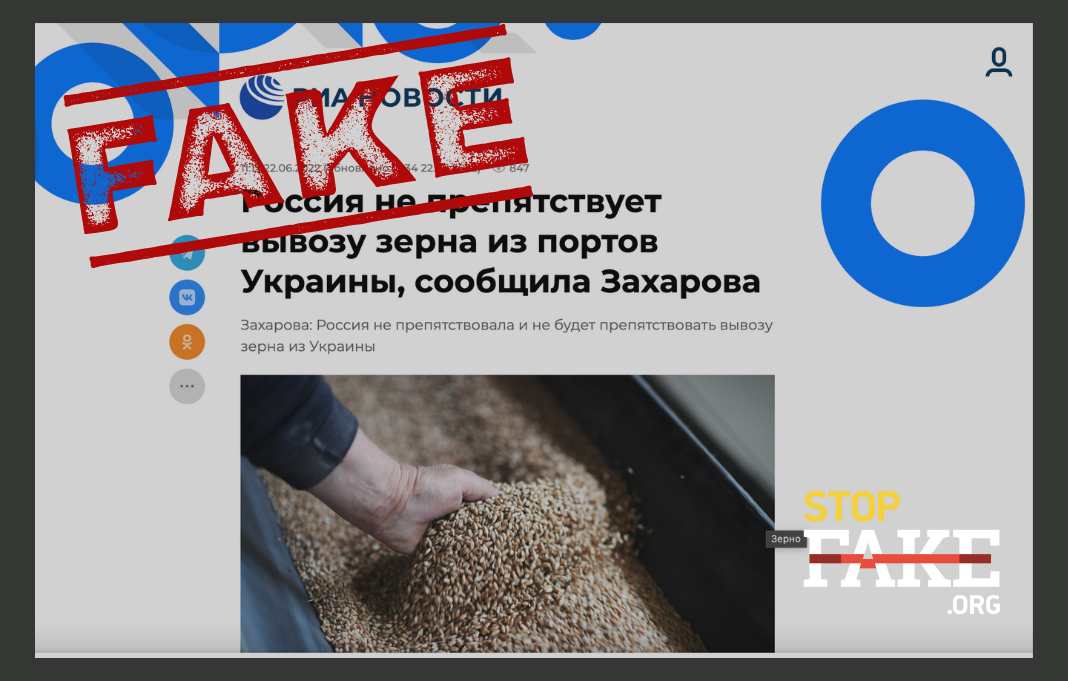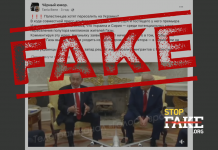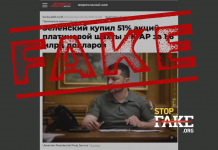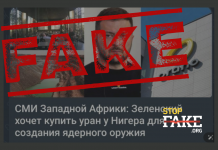Ukrainian grain and Russia’s blockade of Ukrainian ports have become one of the central themes for Russian propaganda since the beginning of the full-scale invasion of Ukraine. The range of Russian narratives on this topic is vast: from statements that Russia is “not involved” in the shelling of Ukrainian grain storage facilities and grain export port infrastructure, to stories about a “global conspiracy” against Russia, which is “not allowed to trade” grain, stolen from temporarily occupied Ukrainian territories.
StopFake collected and analyzed the main Russian narratives about Ukrainian grain.
Fake: After the “grain agreement” all accusations against Russia fall flat – the agreement proves that Russia has not been preventing grain export from Ukraine, it is actually the countries of the West, who want to cause global hunger and blame it on Russia.
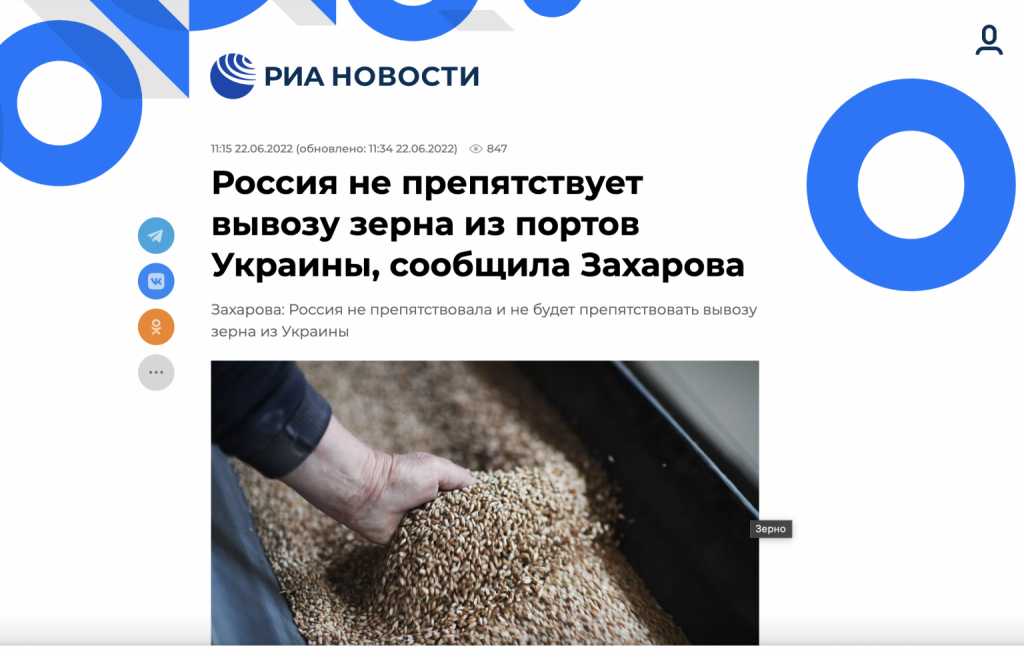
Fact: Russia began spreading the narrative that it was allegedly not involved in blocking the export of Ukrainian grain right after its large-scale invasion into Ukraine began. In fact, it is Russia that blocks Ukraine’s Black Sea ports and uses this as leverage on Ukraine’s international partners.
Russia’s statement is refuted by an overwhelming array of facts, not only from the Ukrainian authorities, who have repeatedly stated that Ukraine needs a safe corridor to exit its own ports, but also by data from other countries. Leading international organizations have also repeatedly noted that since the invasion of Ukraine Russia has deliberately blocked a hundred ships in the Black and Azov seas.
European leaders are certain that Russia’s policy of blocking Ukrainian grain is a policy of blackmail, using food as a weapon against the whole world.
US Secretary of State Antony Blinken has repeatedly said that it is Russia who is responsible for the global food crisis. According to Blinken, the dangerous food situation was provoked solely by Russia’s military blockade of Ukrainian ports.
According to the United Nations Food and Agriculture Organization (FAO) Ukraine is among the five largest global exporters of grain, annually supplying more than 45 million tons of grain to the world market. Because of Russia’s blockade of Black Sea ports in Ukraine there are still 18-22 millions of tons of last year’s grain and oil crops waiting to be exported. Alternative rail and river routes cannot make up for the loss of exports by sea transport and solve the problem, FAO experts say.
The Black Sea is the main trade route for the transportation of grain, oil and petroleum products. Trade ships access the Mediterranean Sea and the world’s oceans through the Bosphorus. This sea route is strategic for Ukraine, Georgia, Turkey and some European countries. Russia uses it as one of the leverages on Ukraine’s international partners.
Fake: Missile strike on the Port of Odesa won’t affect the export of Ukrainian grain – the Kremlin is not responsible for the attack on Odesa infrastructure

Fact: Agreements between Ukraine, Turkey, the UN, as well as Russia on lifting the blockade of the Ukrainian ports Odesa, Chornomorsk and Pivdennyi were signed in Istanbul on July 22. Less than a day later, Russia launched missile strikes on the Odesa port infrastructure, from where the shipment of grain to other countries was to begin. Two Russian Kalibr missiles hit port facilities, two more were shot down by Ukrainian air defenses.
For a day, Russia denied its involvement in the attack on Odesa, making up various excuses, but eventually took responsibility for the attack, saying that it targeted “military infrastructure.” This statement is fake, and is debunked in this article by StopFake.
The narrative that a missile attack on the port of Odesa will not affect the export of Ukrainian grain is pure disinformation: in one of the clauses of the “grain agreements” signed on July 22, it is clearly stated that attacking the ports used to export the grain is forbidden.
The missile attack carried out by Russia on Odesa the day after signing the agreement on lifting the blockade of Ukrainian ports has put many countries of the world at real risk of starvation, said the President of the European Council, Charles Michel. He emphasized that the Russian strikes on Odesa were further proof that «only Russia bears responsibility for the current food crisis and starvation threat in the world».
The UN Secretary-General António Guterres unequivocally condemned the strikes, and added that all parties made clear commitments while signing the agreement on the grain export.
The US Ambassador to Ukraine Bridget Brink called the missile strike “outrageous”. She emphasized that “The Kremlin continues to weaponize food. Russia must be held to account”.
Fake: Only Ukrainian mines are preventing grain export from the ports
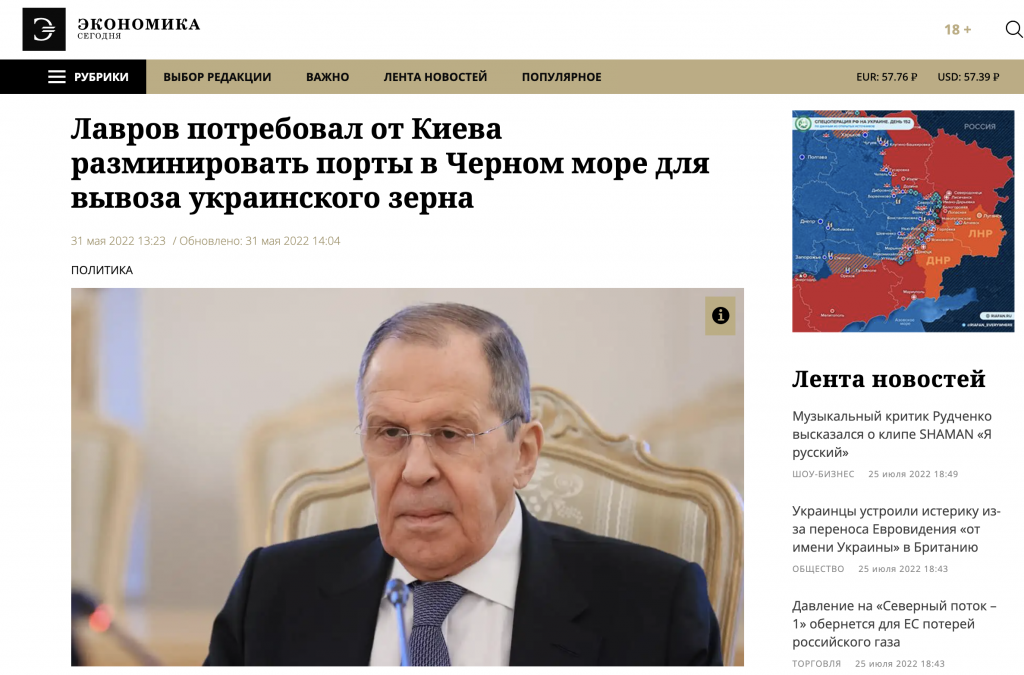
Fact: The threat to safe navigation in the Black and Azov seas is created by Russia, which blocks waterways and fires at civilian foreign ships. The Ukrainian Foreign Ministry has repeatedly debunked the Russian narrative about Ukrainian mines. The Ministry emphasized that by attacking Ukraine, Russia has besieged Ukrainian sea ports and is constantly trying to break through the defense of Odesa and other Black Sea coastal cities. Ukrainian authorities have also repeatedly highlighted that the main obstacles to the export of Ukrainian grain by sea are Russian warships and the danger they pose to trade, commerce and cargo transportation.
Russia’s statement that it is Ukraine that “detains” and “blocks” dozens of foreign trade ships in its ports, thereby preventing the transportation of Ukrainian grain, turned out to be disinformation.
According to the International Maritime Organization (a specialized agency of the United Nations), at the beginning of Russia’s full-scale invasion of Ukraine, about 2,000 sailors were stranded on board of 94 ships in Ukrainian ports because of the war. Moreover, earlier the International Maritime Organization claimed that it was Russia, not Ukraine, that was attacking commercial and trade ships, as well as search and rescue ships in Black and Azov seas. The facts of Russia attacking civilian foreign ships in the Black Sea were confirmed by the US State Department.
Fake: Ukraine is burning its own grain fields and destroying grain elevators
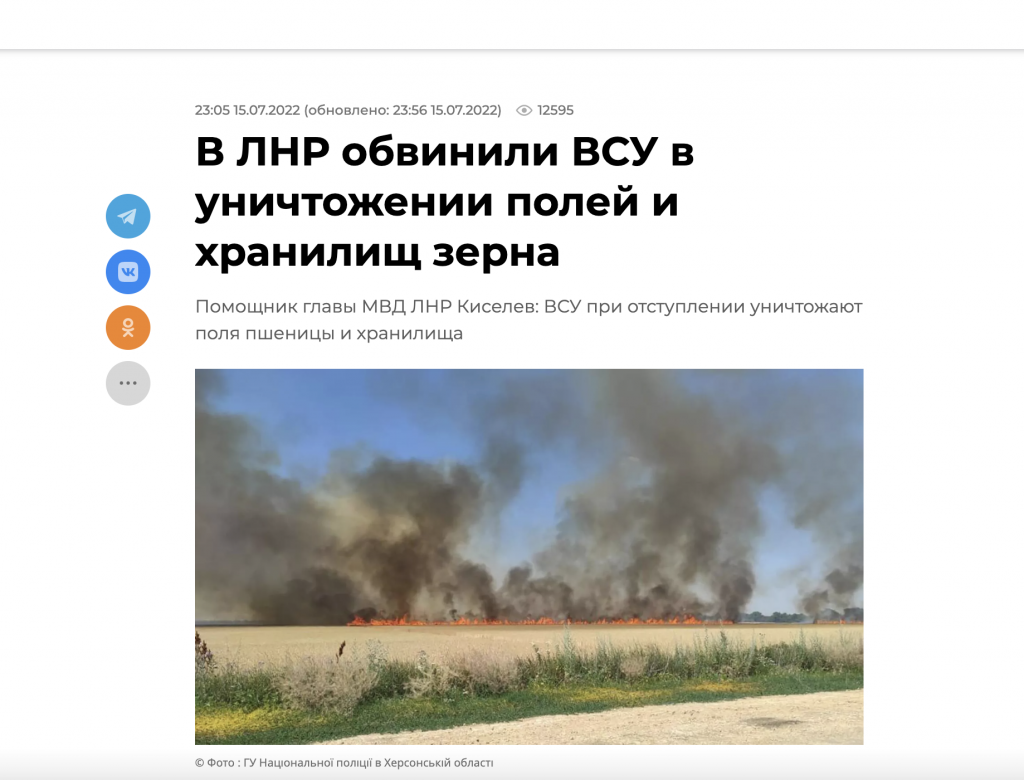
Fact: The Ukrainian Armed forces do not target Ukrainian grain storage facilities and do not destroy their own grain stocks. It is Russia that continues to follow a scorched-earth strategy in Ukraine and purposefully attacks Ukrainian civilian infrastructure. The Russian occupiers are solely responsible for a number of destroyed grain storages, grain elevators and grain fields throughout Ukraine.
The US Center for Strategic and International Studies (CSIS) published several articles proving that the Russian military attacks on Ukrainian agriculture and grain theft testify to Russia’s deliberate attempts to destroy Ukraine’s agricultural potential.
President of the European Commission Ursula von der Leyen also confirmed that Russia is deliberately destroying Ukrainian agricultural infrastructure and drew parallels between Russian occupiers’ current actions in Ukraine and the actions of the Soviet authorities in the 1930s, which brought on the genocidal famine – Holodomor. According to her, it is perfectly clear that the Russian authorities are continuing the bloody legacy of the USSR, using old Soviet methods to exterminate Ukrainians.
“In Russian-occupied Ukraine, the Kremlin’s army is confiscating grain stocks and machinery. For some, this has brought back memories from a dark past – the times of the Soviet crop seizures and the devastating famine of the 1930s. Today, Russian artillery is bombarding grain warehouses across Ukraine. Deliberately. And Russian warships in the Black Sea are blockading Ukrainian ships full of wheat and sunflower seeds” – emphasized Ursula von der Leyen.
Attacks on civil infrastructure and looting temporarily occupied territory is a violation of international law. These facts can be considered war crimes. Investigation of Russian illegal actions in Ukraine by the International Criminal Court began back in March 2022.
StopFake has already debunked similar Russian narratives, for more details read our article Fake: The Armed Forces of Ukraine destroyed a grain elevator in Rubizhne on 24 of June.
Fake: The West is lying about Ukrainian grain being stolen by Russia
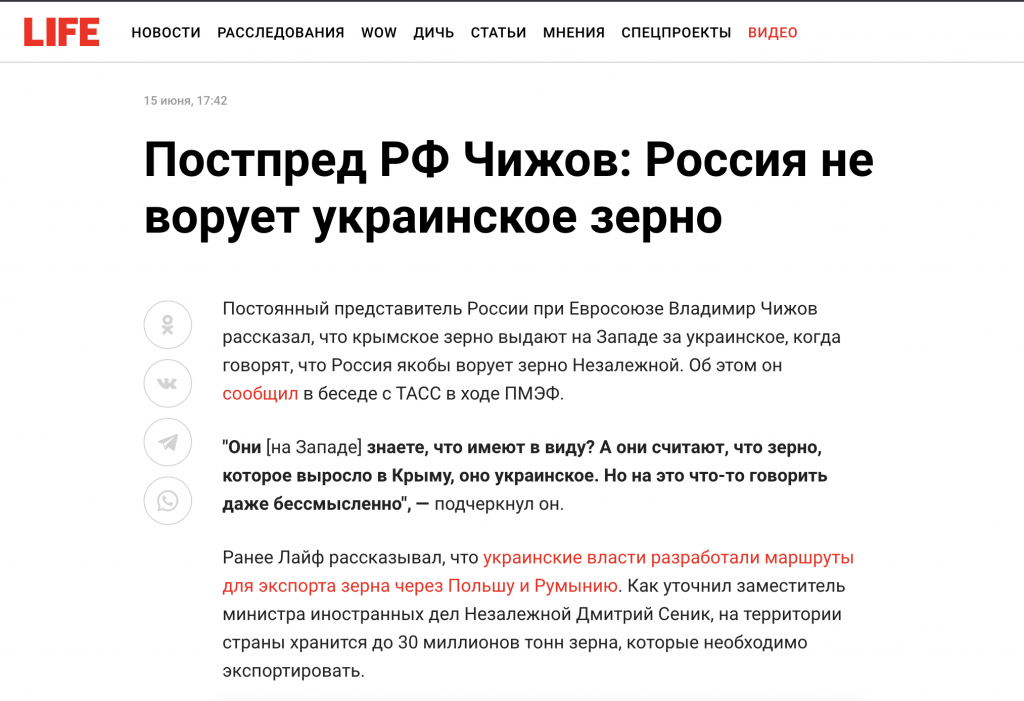
Fact: The Russian occupying forces continue to illegally loot the property of Ukrainian farms, seizing products and agricultural machinery. Since the beginning of the full-scale invasion, the Russian military has withdrawn up to 400 thousand tons of grain crops from the temporarily occupied territories of Ukraine. This information is confirmed by Ukraine’s international partners as well. In addition, in the era of satellites, it is impossible to keep the cat in a bag — the criminal theft of Ukrainian grain by Russia is recorded by spacecraft.
There is a large array of satellite images that confirm Russia’s theft of Ukrainian grain.
For instance, satellite images taken in June show ships under the Russian flag taking stolen Ukrainian grain to Syria. Images from May by a tech company Maxar Technologies and the investigation of the CNN news channel showed two cargo ships under the Russian flag loaded with stolen Ukrainian grain and leaving for Beirut from occupied Sevastopol.
The UN Food and Agriculture Organization also has said it has unofficial but trustworthy data about Russian thefts of Ukrainian grain.
Fake: Russia has saved Ukrainian sowing campaign and has given water for watering the crops to southern Ukrainian farmers
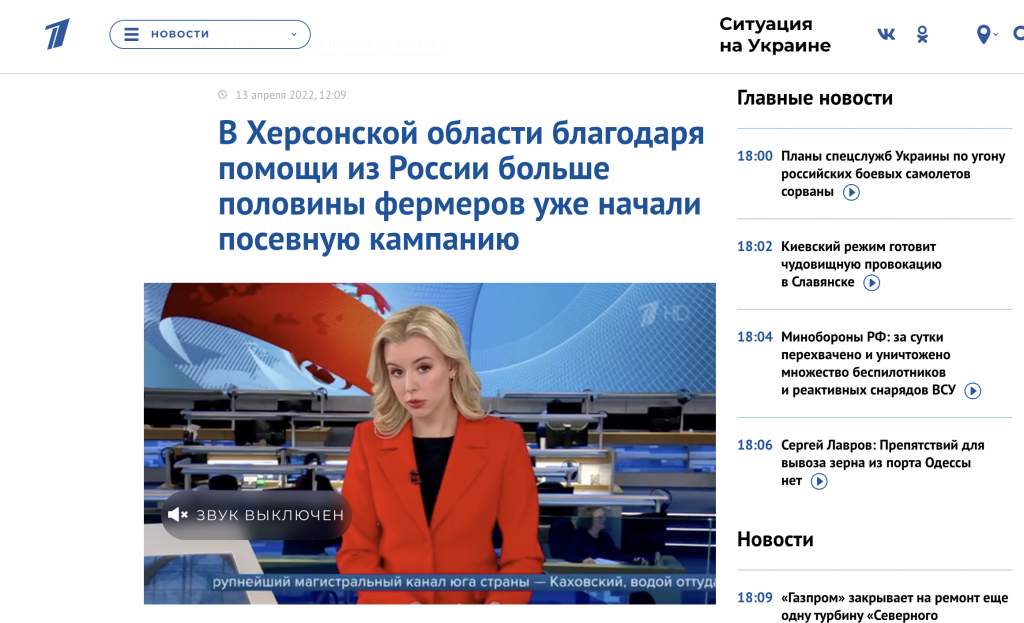
Fake: The thesis that the Kherson region allegedly “got access to water” only after the bloody Russian invasion is a continuation of the Kremlin narrative about the “drought” and mythical “ecological disaster” in the Kherson region, which allegedly occurred there after the closure of the North Crimean Canal (NCC) in 2014. The management of the North Crimean Canal have repeatedly refuted propagandist stories about “the droughts” and “farmers’ lack of water” in the Kherson region.
In reality, the North Crimean Canal in the Kherson region is under constant supervision, it is periodically inspected, maintained and repaired. Every year, before the sowing campaign starts, the North Crimean Canal is cleared of winter debris. In early February of 2022 – several weeks before Russia’s full-scale invasion in Ukraine – the annual planned preparation of the canal for the sowing season began as well: hydrotechnical structures were cleared from winter pollution and a planned repair of the structures was conducted. Thus the Russian occupiers captured the canal in a fully operational state, and prepared for the sowing season by the employees of the North Crimean Canal administration. It is therefore evident that Russia did not supply the region with water.


